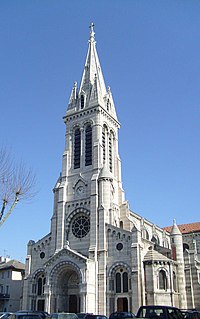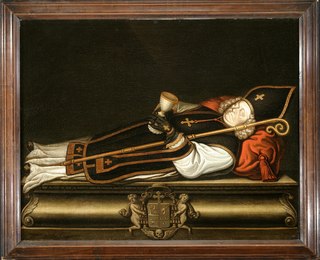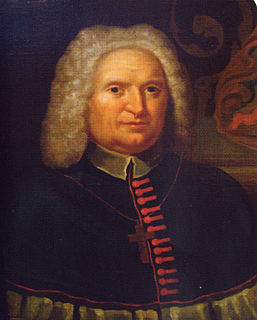Related Research Articles
The terms Old Catholic Church, Old Catholics and Old-Catholic churches designate "any of the groups of Western Christians who believe themselves to maintain in complete loyalty the doctrine and traditions of the undivided church but who separated from the see of Rome after the First Vatican council of 1869–70".

Sedevacantism is a doctrinal position within traditionalist Catholicism which holds that the present occupier of the Holy See is not a valid pope due to the pope's espousal of one or more heresies and that therefore, for lack of a valid pope, the See of Rome is vacant.

The Old Catholic Church of the Netherlands, sometimes known as the Ancient Catholic Church, Dutch Roman Catholic Church of the Old Episcopal Order, the Church of Utrecht , or Jansenist Church of Holland, is an Old Catholic jurisdiction originating from the Archdiocese of Utrecht (695–1580). The Old Catholic Church of the Netherlands is the mother church the Old Catholic Union of Utrecht.
The Holland Mission or Dutch Mission was the common name of a Catholic Church missionary district in the Low Countries during and after the Protestant Reformation.

The Diocese of Gap and Embrun is a Latin Church ecclesiastical territory or diocese of the Catholic Church in Provence-Alpes-Côte d'Azur region of Southern France.
The Ultrajectine tradition is that of the Old Catholic Church of the Netherlands headquartered at Utrecht, Netherlands. Ultrajectine thought holds to the words of Vincent of Lérins's Commonitory: "We must hold fast to that faith which has been held everywhere, always, and by all the faithful." Ultrajectine thought rejects papal supremacy and papal infallibility, and holds to the belief that only the Church in ecumenical council may speak infallibly.

In the Catholic Church, a bishop is an ordained minister who holds the fullness of the sacrament of holy orders and is responsible for teaching doctrine, governing Catholics in his jurisdiction, sanctifying the world and representing the Church. Catholics trace the origins of the office of bishop to the apostles, who it is believed were endowed with a special charism by the Holy Spirit at Pentecost. Catholics believe this special charism has been transmitted through an unbroken succession of bishops by the laying on of hands in the sacrament of holy orders.

The Roman Catholic Diocese of Moulins is a diocese of the Latin Rite of the Roman Catholic Church in France. The episcopal see is located in the city of Moulins. The diocese comprises all of the department of Allier in the region of Auvergne.
Alexander Vaus [Vause, de Vaus] was a late 14th century and 15th century Scottish prelate. Said to have been the younger son of one Patrick Vaus, he apparently held "church livings" in Galloway as early as 1421.

The Lordship of Utrecht was formed in 1528 when Charles V of Habsburg conquered the Bishopric of Utrecht, during the Guelders Wars.

Dominique-Marie Varlet was a French prelate and missionary of the Catholic Church who served as vicar general of the Diocese of Quebec. Later, as the Roman Catholic Bishop of Babylon, he caused a schism within the Roman Catholic Church by consecrating four men successively as Archbishop of Utrecht.
The Society of Mercy is a group of Old Catholic. The Society is a descendant of the church begun by Archbishop Arnold Harris Mathew in 1910 and formerly part of the Church of Utrecht. The Society maintains the traditional dogmas of Catholic Christianity while emphasizing the necessity of a pastoral approach.

The Old Catholic Archdiocese of Utrecht is an archdiocese within the Old Catholic Church of the Netherlands which split from the Archdiocese of Utrecht officially in 1723 because of the illicit consecration of Cornelius van Steenoven to the episcopate.

Cornelis van Steenoven was a Dutch Roman Catholic priest who later served as the seventh Old Catholic Archbishop of Utrecht from 1724 to 1725. Consecrated without the permission of the pope, Steenoven was at the center of the 18th-century controversy between national churches and what many considered to be the overreaching powers of the papacy.

Theodorus van der Croon (1668-1739) served as the ninth Archbishop of Utrecht from 1734 to 1739.
Petrus Johannes Meindaerts served as the tenth Archbishop of Utrecht from 1739 to 1767. After the death of his consecrator, Bishop Dominique Marie Varlet, Meindaerts consecrated other bishops, such that all later Old Catholic bishops derive their apostolic succession from him.
Johannes van Santen served as the fourteenth Archbishop of Utrecht from 1825 to 1858. He was part of the last attempt of the Church of Utrecht to reconcile with the Roman Catholic Church at that time.

Johannes Heykamp served as the sixteenth Archbishop of Utrecht from 1875 to 1892. A learned theologian, Heykamp is most remembered for summoning the conference that led to the Declaration of Utrecht.
Antonio Claudio Álvarez de Quiñones was a Spanish-born prelate of the Roman Catholic Church in what is now the Dominican Republic and Colombia.

Giacomo Lanfredini was a Roman Catholic cardinal who served as Cardinal-Deacon of Santa Maria in Portico (1734–1741) and Bishop of Osimo e Cingoli (1734–1740).
References
Dupac de Bellegarde, Gabriel (1852). Histoire abrégée de l'église métropolitaine d'Utrecht. Utrecht: J. A. van Woestenber. ISBN 0-9764025-9-9.
Moss, C.B. (1948). The Old Catholic Movement: Its Origins and History. Berkeley, CA: The Apocryphal Press. ISBN 9780976402596.